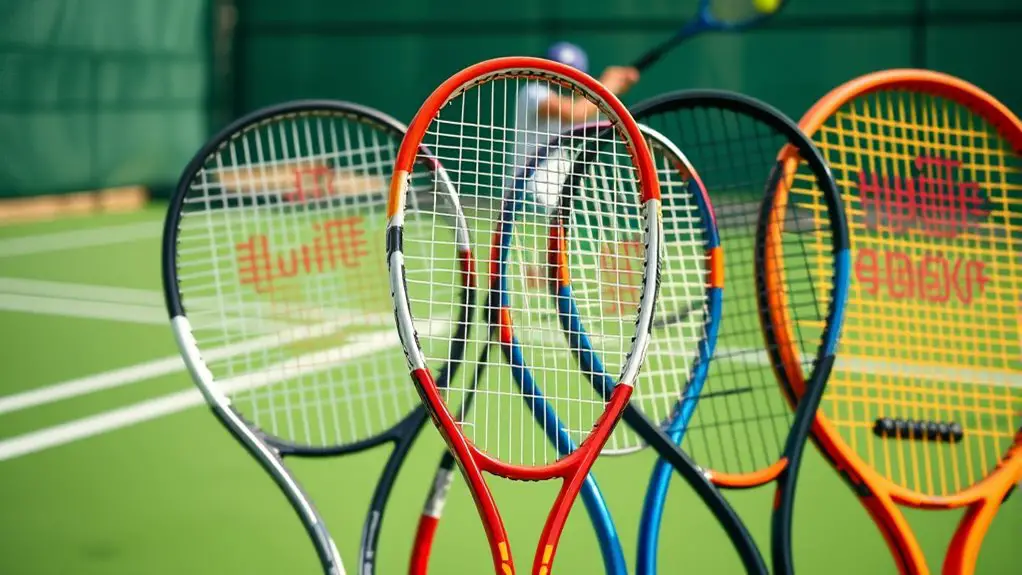When picking the best tennis racket as a beginner, focus on lightweight options (9-10 ounces) for better maneuverability, and choose a grip size that feels comfortable in your hand. Opt for a midplus head size (98-104 sq in) for a balance of power and control. Consider racket balance—head-light for quick reactions or head-heavy for more power. Testing different rackets is key to finding your fit. Keep exploring to uncover more essential tips on selecting the perfect racket.
Understanding Racket Weight
When diving into the world of tennis, understanding racket weight is essential for any beginner. The weight of your racket can greatly impact your game, influencing your swing speed, power, and control. Generally, lighter rackets (around 9-10 ounces) offer more maneuverability, making them perfect for those just starting out. You'll find it easier to swing and react quickly, giving you more freedom on the court.
On the other hand, heavier rackets (11 ounces and up) provide more stability and power, which might be appealing as you gain strength and experience. However, they can be challenging to handle for beginners.
Ultimately, it's about finding a balance that feels right for you. Pick up a few rackets to see how they feel in your hands. The right weight will help you move freely and enjoy the game, allowing your skills to flourish as you grow in confidence on the court.
Choosing the Right Grip Size
When it comes to choosing the right grip size for your tennis racket, measuring is key. A comfortable grip not only helps with your control but also prevents injuries. Let's explore how to find the perfect fit for your hand.
Measuring Grip Size
Choosing the right grip size for your tennis racket is essential for comfort and control, and it can greatly impact your performance on the court. To measure your grip size, follow these steps:
- Hold a racket: Grab a racket with a standard grip and see how it feels.
- Use the index finger test: Place your index finger between your fingers and palm. If it fits snugly, you've got the right size.
- Measure the length: Measure from the tip of your ring finger to the second line on your palm. This measurement correlates with grip sizes.
- Try different grips: Don't hesitate to test various rackets to find what feels best for you.
Finding your perfect grip size can boost your confidence and game!
Importance of Comfort
Comfort plays an essential role in enhancing your tennis experience, especially when it comes to grip size. If your grip's too small, you might find yourself squeezing tightly, leading to fatigue and discomfort. On the flip side, a grip that's too large can cause awkward wrist movements and affect your control. You wanna feel free and confident with each swing, right?
Finding the right grip size lets you play longer without pain, allowing you to focus on your game. A comfortable grip also enhances your feel for the racket, improving your connection with the ball. So, take the time to choose a grip that fits you just right, and enjoy the freedom of playing your best tennis!
Exploring Head Size Options
Head size plays an essential role in your tennis racket selection, especially for beginners. The right head size can greatly influence your game, making it easier to hit the ball with power and control. Here's a quick breakdown of head sizes:
Choosing the right head size in a tennis racket is crucial for beginners, enhancing power and control on the court.
- Oversized (105+ sq in): Offers a larger sweet spot, ideal for gaining confidence and consistency in your strokes.
- Midplus (98-104 sq in): Balances power and control, making it a popular choice for players looking to improve their skills.
- Midsize (85-97 sq in): Provides more precision and control but requires better technique to maximize performance.
- Super Oversized (110+ sq in): Great for those seeking extreme power, but it can sacrifice some control.
Choose a head size that aligns with your playing style and comfort level. Embrace the freedom to explore different options to find the racket that truly feels right for you!
The Importance of Racket Balance
While many beginners focus on head size, understanding racket balance is equally essential for enhancing your game. Racket balance refers to how weight is distributed throughout the frame, and it can greatly influence your performance on the court. You'll typically find rackets classified as head-heavy, head-light, or evenly balanced.
A head-heavy racket offers more power, making it easier to hit deep shots, while a head-light racket provides better maneuverability, allowing for quicker reactions at the net. If you prefer a blend of both, an evenly balanced racket might be your best bet.
Choosing the right balance can impact your comfort and control. When you swing, the balance affects how the racket feels in your hand. So, take the time to try different options and see what feels most natural. It's all about finding that perfect freedom in your swing that helps elevate your game!
String Pattern and Its Impact
Understanding racket balance is just one aspect of finding the right equipment; string pattern also plays a significant role in your play. Different string patterns can affect your control, spin, and power. Here's what you should consider:
Racket balance is important, but string pattern significantly impacts your control, spin, and power on the court.
- Open String Pattern: More spacing between strings allows for greater spin potential, making it easier to hit those powerful topspin shots.
- Dense String Pattern: Tighter strings provide more control over your shots, which is ideal if you're looking to place the ball accurately.
- Hybrid Patterns: Combining open and dense strings can give you a mix of both spin and control, perfect for players who want versatility.
- String Tension: Higher tension means more control, while lower tension offers more power; adjust based on your playing style.
Choose wisely, and you'll discover how string pattern can elevate your game!
Material Composition of Rackets
When selecting a tennis racket, the material composition is essential because it directly influences the racket's performance and feel. Most rackets are made from materials like graphite, aluminum, or a mix of both. Graphite offers a lightweight and flexible feel, making it great for control and power, while aluminum is sturdy and often more affordable, ideal for beginners.
Here's a quick comparison of common materials:
| Material | Pros |
|---|---|
| Graphite | Lightweight, powerful |
| Aluminum | Durable, budget-friendly |
| Composite | Balanced performance |
Choosing the right material can greatly impact your game. If you're just starting, you might prefer a racket with a composite or aluminum frame for its durability. As you progress, you could shift to a graphite frame for enhanced control and feel. Select a racket that resonates with your playing style and enjoy the freedom of the game!
Price Range Considerations
When you're choosing a tennis racket, price can play a big role in your decision. You'll want to balance budget-friendly options with the long-term value they might offer. Investing in a quality racket now could save you money down the line as you improve your game.
Budget-Friendly Options
While you might be enthusiastic to plunge into the world of tennis, it's essential to contemplate your budget when choosing a racket. Fortunately, there are plenty of budget-friendly options that won't break the bank. Here are some tips to keep in mind:
- Set a Price Limit: Determine how much you're willing to spend before shopping.
- Look for Discounts: Check for sales or promotions, especially at the start of the season.
- Consider Used Rackets: Explore second-hand options; you might find a gem at a lower price.
- Focus on Value: Prioritize features like weight and grip comfort over brand names.
With these strategies, you can find a great racket that fits your budget and helps you enjoy the game!
Long-Term Investment Value
Investing in a good tennis racket not only enhances your playing experience but can also save you money in the long run. While it's tempting to grab the cheapest option, a quality racket can boost your performance and last longer, reducing the need for frequent replacements. Look for rackets in the $100 to $200 range, as they often strike the perfect balance between quality and price. These rackets provide better materials and technology, which can elevate your game. By choosing wisely now, you're not just spending money; you're making a long-term investment in your skills and enjoyment. Remember, a reliable racket can open the door to countless hours of freedom on the court.
Trying Out Rackets Before Buying
Trying out rackets before buying is an essential step for beginners aiming to find the right fit. You'll want to make sure your racket feels comfortable and enhances your game. Here are some tips for trying out rackets:
Testing rackets before purchase is crucial for beginners to ensure comfort and performance enhancement.
- Visit a Local Store: Find a shop that allows you to demo rackets. This way, you can physically feel the weight and balance.
- Test Different Brands: Each brand has unique designs. Experiment with various brands to discover which one resonates with your style.
- Play with a Partner: Bring a friend along to hit some balls. This not only helps you gauge performance but also adds fun to the process.
- Take Notes: After trying each racket, jot down how it felt. Consider factors like comfort, control, and power to help you decide.
Frequently Asked Questions
What Age Should a Child Start Playing Tennis?
You can start introducing your child to tennis as young as 4 or 5. It's all about making it fun and engaging. Let them explore the game at their own pace, and they'll love it!
How Often Should Beginners Practice to Improve?
You should practice at least two to three times a week to see improvement. Consistency's key, so find a rhythm that fits your lifestyle, and remember, it's about enjoying the game while you grow!
Can Beginners Use Advanced Rackets?
Can you really harness your potential with advanced rackets? While it's tempting, beginners might struggle. It's often better to start with something more forgiving, allowing you to learn the game and enjoy your freedom on the court.
What Are Common Mistakes Beginners Make?
You'll often underestimate your grip size, overthink your swing mechanics, or neglect proper warm-ups. Don't rush your progress; focus on enjoying the game, and let your skills develop naturally without unnecessary pressure.
How Long Do Tennis Rackets Typically Last?
When it comes to tennis rackets, they usually last around one to three years, depending on usage and care. If you're playing regularly, you'll want to keep an eye on their condition to guarantee peak performance.




